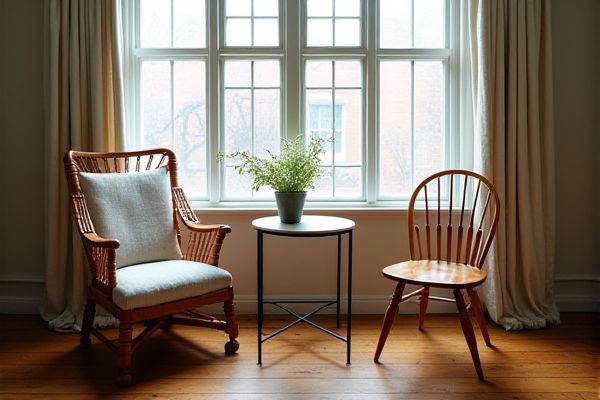
Ladderback chairs offer a rustic charm with horizontal slats on the backrest, providing sturdy support and a traditional look, while Windsor chairs feature a rounded back with spindles radiating from the seat, known for their elegant design and comfort. Discover more about the unique features, history, and best uses of each chair to choose the perfect seating style for Your space by reading the full article.
Table of Comparison
| Feature | Ladderback Chair | Windsor Chair |
|---|---|---|
| Backrest Design | Horizontal slats resembling ladder rungs | Spindled backrest with curved top rail |
| Material | Typically hardwoods like oak or ash | Usually crafted from multiple hardwoods like maple and ash |
| Seat Type | Flat or slightly contoured wooden seat | Shaped, often saddle or scoop-style wooden seat |
| Style Origin | European, popular since the 17th century | English, dates back to early 18th century |
| Durability | Robust and sturdy but simple construction | Strong with reinforced joints for stability |
| Use Case | Casual and rustic interiors | Formal and traditional settings |
| Comfort | Basic support, less ergonomic | Ergonomic back support due to curved spindles |
| Weight | Lighter construction | Potentially heavier due to solid wood components |
Introduction to Ladderback and Windsor Chairs
Ladderback chairs are characterized by their horizontal slats on the backrest, providing sturdy support and a rustic aesthetic, commonly crafted from oak or walnut. Windsor chairs feature a distinctive design with a rounded, spindle-back that offers ergonomic comfort and are traditionally made from ash or maple wood. You can choose between the ladderback's robust, simplistic style or the Windsor's elegant, curved form depending on your interior decor and seating preferences.
Historical Background of Ladderback Chairs
Ladderback chairs, originating in 17th-century England, were traditionally crafted with horizontal slats across the back, designed for durability and comfort in rural homes. These chairs often featured simple, functional forms made from locally sourced wood, reflecting the practical craftsmanship of the period. Understanding the historical background of ladderback chairs highlights their enduring appeal and rustic aesthetic compared to the more ornate Windsor chair style.
Origins and Development of Windsor Chairs
Windsor chairs originated in early 18th-century England, evolving from simpler farmhouse designs into a refined style characterized by turned spindles and sculpted seats. Their development was influenced by the availability of local woods like ash and elm, which allowed for lightweight yet sturdy construction, making them popular for formal and informal settings alike. If you appreciate historic craftsmanship, understanding the Windsor chair's roots highlights its enduring appeal compared to the exposed slat-back design of ladderback chairs.
Key Design Features: Ladderback vs Windsor
Ladderback chairs feature horizontal slats or rungs across the backrest, providing a straightforward, rustic aesthetic often crafted from sturdy wood like oak or ash. Windsor chairs are characterized by a rounded, spindle-supported back with a sculpted seat, typically made from multiple wood types to enhance comfort and durability. The ladderback's emphasis on simple, linear design contrasts with the Windsor's elegant curvature and intricate joinery, making each style distinct in both form and function.
Materials Used in Each Chair Style
Ladderback chairs are traditionally crafted using hardwoods such as oak, ash, or hickory, valued for their durability and rustic charm. Windsor chairs commonly feature a combination of hardwoods like maple or cherry for the seat and softer woods like pine or fir for the spindle back and legs, enhancing comfort and flexibility. Your choice between these styles can influence the material composition, affecting both the chair's aesthetic and longevity.
Comfort and Ergonomics Comparison
Ladderback chairs offer a firm, upright seating experience with evenly spaced horizontal slats that provide moderate back support, making them suitable for short-term use. Windsor chairs feature a contoured, curved back with spindles that cradle the spine, delivering enhanced ergonomic comfort and better posture support for extended sitting periods. The sculpted seat and angled backrest of Windsor chairs reduce pressure points, making them more comfortable than the typically flat seat of ladderback designs.
Craftsmanship and Construction Techniques
Ladderback chairs feature horizontal slats and are traditionally crafted using mortise-and-tenon joinery, emphasizing sturdy, rustic construction with visible dowels or pegs. Windsor chairs showcase a more intricate assembly, combining turned spindles and a sculpted seat formed from a single piece of wood, highlighting advanced steam bending and carving techniques. Both chairs reflect distinct historical craftsmanship; Ladderbacks favor straightforward durability, while Windsor chairs demonstrate refined woodworking skills and detailed joinery.
Typical Uses and Placement in Interiors
Ladderback chairs are commonly used in rustic, farmhouse, or traditional dining rooms and kitchens, offering sturdy support and a cozy, casual aesthetic ideal for everyday seating around wooden tables. Windsor chairs, with their elegant, spindle-back design and light construction, are often placed in more formal dining areas, home offices, or living rooms, providing a classic touch that complements both vintage and contemporary interiors. Your choice between these styles depends on the ambiance you want to create and the level of comfort and formality needed in your space.
Durability and Maintenance Differences
Ladderback chairs, constructed with sturdy wooden slats and simple joints, generally offer excellent durability with minimal maintenance, requiring occasional tightening of joints or cleaning. Windsor chairs feature a more intricate design with spindled backs and splayed legs, which can demand more careful upkeep to prevent joint loosening and wood cracking over time due to their delicate construction. Both chair types benefit from regular dusting and conditioning with wood oils or waxes to maintain structural integrity and appearance.
Choosing Between Ladderback and Windsor Chairs
When choosing between ladderback and Windsor chairs, focus on your space and style preferences. Ladderback chairs feature horizontal slats for back support, offering a rustic, traditional look, while Windsor chairs display spindled backs and splayed legs, showcasing classic elegance and sturdy construction. Your decision depends on whether you want the timeless, farmhouse charm of ladderbacks or the refined craftsmanship and comfort of Windsor chairs.
 homyna.com
homyna.com